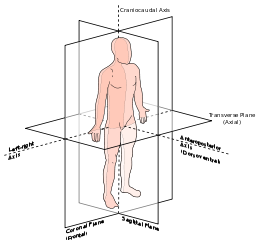To sum up
- Anatomy is the study of the structure of the human body
- Systemic Anatomy and Regional Anatomy are the two basic approaches to the study of anatomy
- The six structural levels of the body are Chemical < Cell < Tissue < Organ < Organ System < Organism
- The Anatomical Position refers to a person (1) standing erect, (2) hands at side, (3) palms facing forward, (4) feet shoulder width apart and (5) toes slightly pointing outward. We use this when we are trying to relate body parts from each other.
- Directional terms include Superior, Inferior, Cephalic, Caudal, Right, Left, Anterior, Posterior, Ventral, Dorsal, Proximal, Distal, Lateral, Medial, Superficial and Deep
Anatomical Planes
Now let's move on to Anatomical Planes.

- Sagittal Plane - divides the body into left and right
- Frontal Plane - divides the body into anterior and posterior
- Transverse Plane - divides the body into superior and inferior
As you can see from the image above we see imaginary flat surfaces passing through the body. These are called planes. In studying anatomy, we often cut the body in two to look inside
and observe the body's structures.
Let's discuss each of these planes. The first one is the Sagittal Plane. It divides the body into left and right. The next one is the Frontal Plane and it divides the body into anterior and posterior. The last one is the Transverse Plane and it divides the body into superior and inferior.